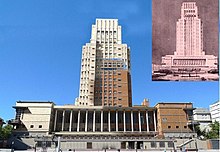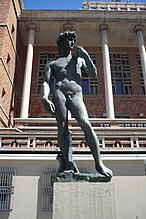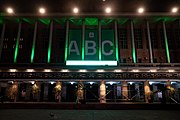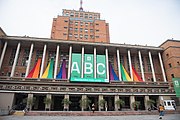
Montevideo is the capital and largest city of Uruguay. According to the 2011 census, the city proper has a population of 1,319,108 in an area of 201 square kilometers (78 sq mi). Montevideo is situated on the southern coast of the country, on the northeastern bank of the Río de la Plata.

La Plata is the capital city of Buenos Aires Province, Argentina. According to the 2022 census, the Partido has a population of 772,618 and its metropolitan area, the Greater La Plata, has 938,287 inhabitants. It is located 9 kilometers inland from the southern shore of the Río de la Plata estuary.

Palacio Salvo is a building at the intersection of 18 de Julio Avenue and Plaza Independencia in Montevideo, Uruguay. It was designed by the architect Mario Palanti, an Italian immigrant living in Buenos Aires, who used a similar design for his Palacio Barolo in Buenos Aires, Argentina. Finished in 1928, Palacio Salvo stands 100 m (330 ft) high with the antenna included. It was the tallest building in Latin America for a brief period.
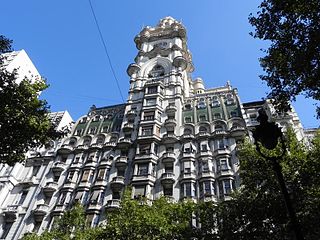
Palacio Barolo is a landmark office building, located at 1370 Avenida de Mayo, in the neighborhood of Montserrat, Buenos Aires, Argentina. It stood as Buenos Aires' tallest building for more than a decade until the construction of the Kavanagh Building in 1936. Its twin brother, Palacio Salvo, is a building designed and erected in Eclectic style, built by the same architect in Montevideo.

Ciudad Vieja is a historic neighbourhood in Montevideo, the capital of Uruguay. Located in a peninsula at the entrance of the natural port of Montevideo it was founded in 1724 as a walled city by the Spanish Empire, after the independence of Uruguay the city rapidly grew outwards and the Ciudad Vieja remained as one of the central neighbourhoods, nowadays it serves as one of the main office districts of Montevideo, housing multiple banks and institutions, but also as one of the main tourist attractions in Uruguay due to its historical significance and classical architecture.

Pocitos is an upscale seaside barrio of Montevideo, Uruguay. It borders Buceo to the east, Parque Batlle to the north, Tres Cruces, Cordón and Parque Rodó to the west and Punta Carretas to the south.

Centro is a barrio of Montevideo, Uruguay. Its main axis is 18 de Julio Avenue, and it runs between Plaza Independencia and Ejido St, being the central business district.

Plaza Independencia is the most important city square in Montevideo, Uruguay, laid out in the 19th century in the area occupied by the Citadel of Montevideo. In its center is a monument to General José Gervasio Artigas, and below it, his mausoleum.

Avenida 18 de Julio, or 18 de Julio Avenue, is the most important avenue in Montevideo, Uruguay. It is named after the date on which the country's first Constitution was sworn in, on July 18, 1830.

Plaza de Cagancha is a public square in barrio Centro of Montevideo, Uruguay. Located on 18 de Julio Avenue, the main avenue of the city, it originated in 1836 as the central space of the layout of the "Ciudad Nueva", outside the limits of the walled area of the colonial period.

Palacio Rinaldi is a building in Centro, Montevideo, Uruguay, located on the Plaza Independencia near its junction with the 18 de Julio Avenue, near the Palacio Salvo.
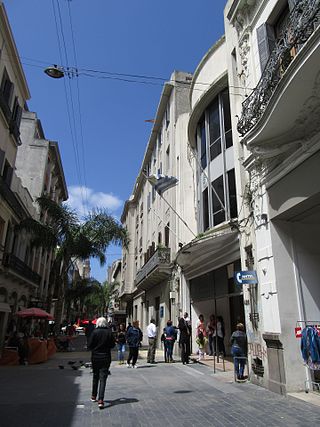
Peatonal Sarandí is an 0.5 miles pedestrian street in Ciudad Vieja, Montevideo, Uruguay. It is the main lane of the historic center, and one of the most touristic sites in the city, due to the fact that it is flanked by different architecturally notable buildings. The pedestrian street starts at the Gateway of the Citadel and ends at its intersection with Peatonal Pérez Castellano, while the remaining four blocks, up to the Rambla, are allowed for vehicles. As an extension of this street is the long southern breakwater of the Port of Montevideo, which has taken on the name "Escollera Sarandí".
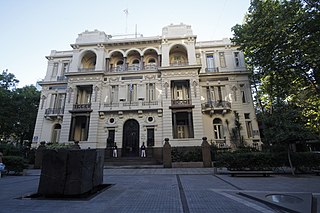
The Piria Palace is the headquarters of the Supreme Court of Uruguay. Located on the south side of the Plaza de Cagancha in Montevideo, on the Human Rights Passage, it was declared a National Historical Monument in 1975. In front of its main entrance is the Monument to Justice, a work by Rafael Lorente Mourelle.

The Buenos Aires Legislature Palace houses the Legislature of the City of Buenos Aires, Argentina. It is an architectural landmark in the city's Montserrat district, situated in a triangular block bounded by the streets Hipólito Yrigoyen Street, Presidente Julio A. Roca Avenue and Perú Street. Built of grey granite, it has a Neoclassical design. The building is open to the public on week-days only. The building contains the Esteban Echeverría Library, Salón Rosado, and a carillon which, when it was installed in 1930, was the largest in South America.
Fernando Octavio Assunção Formica was a Uruguayan historian, anthropologist, scholar, historian, and writer.

The municipality of Bella Unión is one of the municipalities of Artigas Department, Uruguay, established on 13 September 2009. Its seat is the city of Bella Unión. It replaced the Autonomous and Elective Local Board of Bella Union created in 1994.
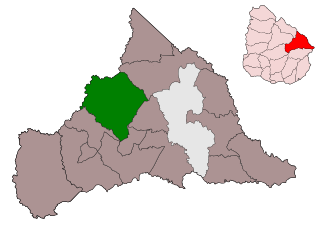
The municipality of Ramón Trigo is one of the municipalities of Cerro Largo Department, Uruguay, established on 3 April 2013. Its seat is the town of Ramón Trigo.

Eva Díaz Torres was a Uruguayan ceramicist, who specialised in the production of Raku ware. A member of the Tupamaros, she was imprisoned for her political beliefs from 1972 to 1974.

The Uruguayan Institute of Meteorology or INUMET for short, is the weather agency that provides meteorological and climatological services to Uruguay. It is also the aeronautical meteorological authority of the country in application of the Convention on International Civil Aviation (ICAO).


